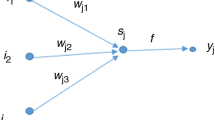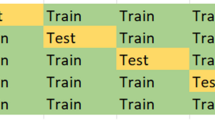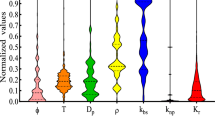Abstract
In the present study, a comprehensive model based on least square support vector machine algorithm (LSSVM) was developed to estimate thermal conductivity of nanofluids. The model assessed the thermal conductivity of 29 different nanofluids. The representative nanofluids were composed of nine base fluids, including water, ethylene glycol, transformer oil, engine oil, R113, DI Water, monoethylene glycol, paraffin, and oil. Al2O3, TiO2, CuO, ZnO, Al, and Cu nanoparticles were employed in the corresponding nanofluids. A collection of 1109 experimental samples from reliable sources was used. In addition, the present model can estimate the thermal conductivity of nanofluids as a function of temperature, diameter, nanoparticle volume fraction as well as the thermal conductivity of the nanoparticles and the base fluid. The proposed LSSVM structure was optimized by particle swarm optimization technique where the outcomes proved great accuracy of the model for estimating the thermal conductivity of nanofluids. Moreover, statistical observations showed superior predictive ability of LSSVM model than other previous available correlations. Namely, the average relative deviation percent of 2.46 and 3.10%, and R-squared values of 0.9954 and 0.9914 were resulted for training and testing stages of LSSVM model, respectively.














Similar content being viewed by others
References
Wen D, Lin G, Vafaei S, Zhang K. Review of nanofluids for heat transfer applications. Particuology. 2009;7:141–50.
Zalba B, Marín JM, Cabeza LF, Mehling H. Review on thermal energy storage with phase change: materials, heat transfer analysis and applications. Appl Therm Eng. 2003;23:251–83.
Tomlinson HL, Manning W, Schaefer W, Record T (2016) Process for increasing the efficiency of heat removal from a Fischer–Tropsch slurry reactor, Google Patents.
Ebrahimnia-Bajestan E, Moghadam MC, Niazmand H, Daungthongsuk W, Wongwises S. Experimental and numerical investigation of nanofluids heat transfer characteristics for application in solar heat exchangers. Int J Heat Mass Transf. 2016;92:1041–52.
Mazumdar A, Spencer SJ, Hobart C, Kuehl M, Brunson G, Coleman N, Buerger SP. Improving robotic actuator torque density and efficiency through enhanced heat transfer. In: ASME 2016 Dynamic Systems and Control Conference. American Society of Mechanical Engineers; 2016, p. V002T026A004.
Eiamsa-Ard S, Wongcharee K. Experimental study of TiO2–water nanofluid flow in corrugated tubes mounted with semi-circular wing tapes. Heat Transf Eng. 2018;39:1–14.
Zeeshan A, Shehzad N, Ellahi R, Alamri SZ. Convective Poiseuille flow of Al2O3–EG nanofluid in a porous wavy channel with thermal radiation. Neural Comput Appl. 2017;28:1–12.
Chol S. Enhancing thermal conductivity of fluids with nanoparticles. ASME Publ Fed. 1995;231:99–106.
Chein R, Chuang J. Experimental microchannel heat sink performance studies using nanofluids. Int J Therm Sci. 2007;46:57–66.
Maxwell JC. A treatise on electricity and magnetism. Oxford: Clarendon Press; 1881.
Murshed S, Leong K, Yang C. Investigations of thermal conductivity and viscosity of nanofluids. Int J Therm Sci. 2008;47:560–8.
Lee J-H, Lee S-H, Choi C, Jang S, Choi S. A review of thermal conductivity data, mechanisms and models for nanofluids. Int J Micro Nano Scale Transp. 2011;1:269–322.
Kleinstreuer C, Feng Y. Experimental and theoretical studies of nanofluid thermal conductivity enhancement: a review. Nanoscale Res Lett. 2011;6:1–13.
Keblinski P, Phillpot S, Choi S, Eastman J. Mechanisms of heat flow in suspensions of nano-sized particles (nanofluids). Int J Heat Mass Transf. 2002;45:855–63.
Vatani A, Woodfield PL, Dao DV. A survey of practical equations for prediction of effective thermal conductivity of spherical-particle nanofluids. J Mol Liq. 2015;211:712–33.
Ariana M, Vaferi B, Karimi G. Prediction of thermal conductivity of alumina water-based nanofluids by artificial neural networks. Powder Technol. 2015;278:1–10.
Baghban A, Pourfayaz F, Ahmadi MH, Kasaeian A, Pourkiaei SM, Lorenzini G. Connectionist intelligent model estimates of convective heat transfer coefficient of nanofluids in circular cross-sectional channels. J Therm Anal Calorim. 2017;130:1–27.
Baghban A, Ahmadi MA, Shahraki BH. Prediction carbon dioxide solubility in presence of various ionic liquids using computational intelligence approaches. J Supercrit Fluids. 2015;98:50–64.
Baghban A, Bahadori A, Mohammadi AH, Behbahaninia A. Prediction of CO2 loading capacities of aqueous solutions of absorbents using different computational schemes. Int J Greenh Gas Control. 2017;57:143–61.
Baghban A, Bahadori M, Rozyn J, Lee M, Abbas A, Bahadori A, Rahimali A. Estimation of air dew point temperature using computational intelligence schemes. Appl Therm Eng. 2016;93:1043–52.
Baghban A, Mohammadi AH, Taleghani MS. Rigorous modeling of CO2 equilibrium absorption in ionic liquids. Int J Greenh Gas Control. 2017;58:19–41.
Bahadori A, Baghban A, Bahadori M, Lee M, Ahmad Z, Zare M, Abdollahi E. Computational intelligent strategies to predict energy conservation benefits in excess air controlled gas-fired systems. Appl Therm Eng. 2016;102:432–46.
Baghban A, Kardani MN, Habibzadeh S. Prediction viscosity of ionic liquids using a hybrid LSSVM and group contribution method. J Mol Liq. 2017;236:452–64.
Karimi H, Yousefi F, Rahimi MR. Correlation of viscosity in nanofluids using genetic algorithm-neural network (GA-NN). Heat Mass Transf. 2011;47:1417–25.
Atashrouz S, Pazuki G, Alimoradi Y. Estimation of the viscosity of nine nanofluids using a hybrid GMDH-type neural network system. Fluid Phase Equilib. 2014;372:43–8.
Sharifpur M, Adio SA, Meyer JP. Experimental investigation and model development for effective viscosity of Al2O3–glycerol nanofluids by using dimensional analysis and GMDH-NN methods. Int Commun Heat Mass Transf. 2015;68:208–19.
Karimi H, Yousefi F. Application of artificial neural network–genetic algorithm (ANN–GA) to correlation of density in nanofluids. Fluid Phase Equilib. 2012;336:79–83.
Hojjat M, Etemad SG, Bagheri R, Thibault J. Thermal conductivity of non-Newtonian nanofluids: experimental data and modeling using neural network. Int J Heat Mass Transf. 2011;54:1017–23.
Papari MM, Yousefi F, Moghadasi J, Karimi H, Campo A. Modeling thermal conductivity augmentation of nanofluids using diffusion neural networks. Int J Therm Sci. 2011;50:44–52.
Longo GA, Zilio C, Ceseracciu E, Reggiani M. Application of artificial neural network (ANN) for the prediction of thermal conductivity of oxide–water nanofluids. Nano Energy. 2012;1:290–6.
Esfe MH, Afrand M, Yan W-M, Akbari M. Applicability of artificial neural network and nonlinear regression to predict thermal conductivity modeling of Al2O3–water nanofluids using experimental data. Int Commun Heat Mass Transf. 2015;66:246–9.
Meybodi MK, Naseri S, Shokrollahi A, Daryasafar A. Prediction of viscosity of water-based Al2O3, TiO2, SiO2, and CuO nanofluids using a reliable approach. Chemom Intell Lab Syst. 2015;149:60–9.
Maxwell J. Electricity and magnetism. Oxford: Clarendon Press; 1873.
Hamilton R, Crosser O. Thermal conductivity of heterogeneous two-component systems. Ind Eng Chem Fundam. 1962;1:187–91.
Bruggeman VD. Berechnung verschiedener physikalischer Konstanten von heterogenen Substanzen. I. Dielektrizitätskonstanten und Leitfähigkeiten der Mischkörper aus isotropen Substanzen. Ann Phys. 1935;416:636–64.
Yu W, Choi S. The role of interfacial layers in the enhanced thermal conductivity of nanofluids: a renovated Maxwell model. J Nanopart Res. 2003;5:167–71.
Leong K, Yang C, Murshed S. A model for the thermal conductivity of nanofluids—the effect of interfacial layer. J Nanopart Res. 2006;8:245–54.
Xie H, Fujii M, Zhang X. Effect of interfacial nanolayer on the effective thermal conductivity of nanoparticle-fluid mixture. Int J Heat Mass Transf. 2005;48:2926–32.
Sohrabi N, Masoumi N, Behzadmehr A, Sarvari S. A simple analytical model for calculating the effective thermal conductivity of nanofluids. Heat Transf Asian Res. 2010;39:141–50.
Koo J, Kleinstreuer C. A new thermal conductivity model for nanofluids. J Nanopart Res. 2004;6:577–88.
Xu J, Yu B, Zou M, Xu P. A new model for heat conduction of nanofluids based on fractal distributions of nanoparticles. J Phys D Appl Phys. 2006;39:4486.
Evans W, Prasher R, Fish J, Meakin P, Phelan P, Keblinski P. Effect of aggregation and interfacial thermal resistance on thermal conductivity of nanocomposites and colloidal nanofluids. Int J Heat Mass Transf. 2008;51:1431–8.
Schwartz LM, Garboczi EJ, Bentz DP. Interfacial transport in porous media: application to DC electrical conductivity of mortars. J Appl Phys. 1995;78:5898–908.
Tomotika S, Aoi T, Yosinobu H. On the forces acting on a circular cylinder set obliquely in a uniform stream at low values of Reynolds number. In: Proceedings of the Royal Society of London A: Mathematical, Physical and Engineering Sciences, The Royal Society; 1953, p. 233–244.
Prasher R, Phelan PE, Bhattacharya P. Effect of aggregation kinetics on the thermal conductivity of nanoscale colloidal solutions (nanofluid). Nano Lett. 2006;6:1529–34.
He Y, Jin Y, Chen H, Ding Y, Cang D, Lu H. Heat transfer and flow behaviour of aqueous suspensions of TiO2 nanoparticles (nanofluids) flowing upward through a vertical pipe. Int J Heat Mass Transf. 2007;50:2272–81.
Wang B-X, Zhou L-P, Peng X-F. A fractal model for predicting the effective thermal conductivity of liquid with suspension of nanoparticles. Int J Heat Mass Transf. 2003;46:2665–72.
Nan C-W, Birringer R, Clarke DR, Gleiter H. Effective thermal conductivity of particulate composites with interfacial thermal resistance. J Appl Phys. 1997;81:6692–9.
Suykens JA, Vandewalle J. Least squares support vector machine classifiers. Neural Process Lett. 1999;9:293–300.
Suykens JA, Vandewalle J. Recurrent least squares support vector machines. IEEE Trans Circuits Syst I Fundam Theory Appl. 2000;47:1109–14.
Suykens JA, Van Gestel T, De Brabanter J. Least squares support vector machines. Singapore: World Scientific; 2002.
Guo Z, Bai G. Application of least squares support vector machine for regression to reliability analysis. Chin J Aeronaut. 2009;22:160–6.
Nan C-W, Shi Z, Lin Y. A simple model for thermal conductivity of carbon nanotube-based composites. Chem Phys Lett. 2003;375:666–9.
Rashmi W, Khalid M, Ismail AF, Saidur R, Rashid A. Experimental and numerical investigation of heat transfer in CNT nanofluids. J Exp Nanosci. 2015;10:545–63.
Jiang H, Li H, Zan C, Wang F, Yang Q, Shi L. Temperature dependence of the stability and thermal conductivity of an oil-based nanofluid. Thermochim Acta. 2014;579:27–30.
Kazemi-Beydokhti A, Heris SZ, Moghadam N, Shariati-Niasar M, Hamidi A. Experimental investigation of parameters affecting nanofluid effective thermal conductivity. Chem Eng Commun. 2014;201:593–611.
Murshed SS. Simultaneous measurement of thermal conductivity, thermal diffusivity, and specific heat of nanofluids. Heat Transf Eng. 2012;33:722–31.
Patel HE, Sundararajan T, Das SK. An experimental investigation into the thermal conductivity enhancement in oxide and metallic nanofluids. J Nanopart Res. 2010;12:1015–31.
Chon CH, Kihm KD, Lee SP, Choi SU. Empirical correlation finding the role of temperature and particle size for nanofluid (Al2O3) thermal conductivity enhancement. Appl Phys Lett. 2005;87:153107.
Mintsa HA, Roy G, Nguyen CT, Doucet D. New temperature dependent thermal conductivity data for water-based nanofluids. Int J Therm Sci. 2009;48:363–71.
Godson L, Raja B, Lal DM, Wongwises S. Experimental investigation on the thermal conductivity and viscosity of silver-deionized water nanofluid. Exp Heat Transf. 2010;23:317–32.
Thang BH, Khoi PH, Minh PN. A modified model for thermal conductivity of carbon nanotube-nanofluids. Phys Fluids. 2015;27:032002.
Das SK, Putra N, Thiesen P, Roetzel W. Temperature dependence of thermal conductivity enhancement for nanofluids. J Heat Transf. 2003;125:567–74.
Lee S, Choi S-S, Li S, Eastman J. Measuring thermal conductivity of fluids containing oxide nanoparticles. J Heat Transf. 1999;121:280–9.
Kim SH, Choi SR, Kim D. Thermal conductivity of metal-oxide nanofluids: particle size dependence and effect of laser irradiation. J Heat Transf. 2007;129:298–307.
Khedkar RS, Sonawane SS, Wasewar KL. Influence of CuO nanoparticles in enhancing the thermal conductivity of water and monoethylene glycol based nanofluids. Int Commun Heat Mass Transf. 2012;39:665–9.
Zerradi H, Ouaskit S, Dezairi A, Loulijat H, Mizani S. New Nusselt number correlations to predict the thermal conductivity of nanofluids. Adv Powder Technol. 2014;25:1124–31.
Eastman JA, Choi S, Li S, Yu W, Thompson L. Anomalously increased effective thermal conductivities of ethylene glycol-based nanofluids containing copper nanoparticles. Appl Phys Lett. 2001;78:718–20.
Moghadassi A, Hosseini SM, Henneke DE. Effect of CuO nanoparticles in enhancing the thermal conductivities of monoethylene glycol and paraffin fluids. Ind Eng Chem Res. 2010;49:1900–4.
Fedele L, Colla L, Bobbo S. Viscosity and thermal conductivity measurements of water-based nanofluids containing titanium oxide nanoparticles. Int J Refrig. 2012;35:1359–66.
Pastoriza-Gallego M, Lugo L, Cabaleiro D, Legido J, Piñeiro M. Thermophysical profile of ethylene glycol-based ZnO nanofluids. J Chem Thermodyn. 2014;73:23–30.
Mondragón R, Segarra C, Martínez-Cuenca R, Juliá JE, Jarque JC. Experimental characterization and modeling of thermophysical properties of nanofluids at high temperature conditions for heat transfer applications. Powder Technol. 2013;249:516–29.
Halelfadl S, Maré T, Estellé P. Efficiency of carbon nanotubes water based nanofluids as coolants. Exp Therm Fluid Sci. 2014;53:104–10.
Chen L, Xie H, Li Y, Yu W. Nanofluids containing carbon nanotubes treated by mechanochemical reaction. Thermochim Acta. 2008;477:21–4.
Hwang Y, Ahn Y, Shin H, Lee C, Kim G, Park H, Lee J. Investigation on characteristics of thermal conductivity enhancement of nanofluids. Curr Appl Phys. 2006;6:1068–71.
Jiang W, Ding G, Peng H. Measurement and model on thermal conductivities of carbon nanotube nanorefrigerants. Int J Therm Sci. 2009;48:1108–15.
Choi S, Zhang Z, Yu W, Lockwood F, Grulke E. Anomalous thermal conductivity enhancement in nanotube suspensions. Appl Phys Lett. 2001;79:2252–4.
Godson L, Lal DM, Wongwises S. Measurement of thermo physical properties of metallic nanofluids for high temperature applications. Nanoscale Microscale Thermophys Eng. 2010;14:152–73.
Timofeeva EV, Moravek MR, Singh D. Improving the heat transfer efficiency of synthetic oil with silica nanoparticles. J Colloid Interface Sci. 2011;364:71–9.
Wasp EJ, Kenny JP, Gandhi RL. Solid–liquid flow: slurry pipeline transportation. [Pumps, valves, mechanical equipment, economics]. Ser Bulk Mater Handl U S 1977;1.
Corcione M. Empirical correlating equations for predicting the effective thermal conductivity and dynamic viscosity of nanofluids. Energy Convers Manag. 2011;52:789–93.
Azmi W, Sharma K, Mamat R, Alias A, Misnon II. Correlations for thermal conductivity and viscosity of water based nanofluids. In: IOP Conference Series: Materials Science and Engineering. IOP Publishing; 2012, p. 012029.
Vajjha RS, Das DK. Experimental determination of thermal conductivity of three nanofluids and development of new correlations. Int J Heat Mass Transf. 2009;52:4675–82.
Jang SP, Choi SU. Role of Brownian motion in the enhanced thermal conductivity of nanofluids. Appl Phys Lett. 2004;84:4316–8.
Rousseeuw PJ, Leroy AM. Robust regression and outlier detection. New York: Wiley; 2005.
Mohammadi AH, Gharagheizi F, Eslamimanesh A, Richon D. Evaluation of experimental data for wax and diamondoids solubility in gaseous systems. Chem Eng Sci. 2012;81:1–7.
Hosseinzadeh M, Hemmati-Sarapardeh A. Toward a predictive model for estimating viscosity of ternary mixtures containing ionic liquids. J Mol Liq. 2014;200:340–8.
Author information
Authors and Affiliations
Corresponding authors
Electronic supplementary material
Below is the link to the electronic supplementary material.
Appendix: Program
Appendix: Program
I have developed a graphical user interface (GUI) version of the model as illustrated in Fig. 15. This program is an exe file presented in supplementary content, and it needs Matlab software version 2012 (64bit) before running. As indicated, three input parameters (temperature, diameter, and volume fraction) should be given and by choosing one of nanofluid in the panel and then clicking on calculate button, the thermal conductivity of nanofluid is obtained.
Rights and permissions
About this article
Cite this article
Baghban, A., Habibzadeh, S. & Ashtiani, F.Z. Toward a modeling study of thermal conductivity of nanofluids using LSSVM strategy. J Therm Anal Calorim 135, 507–522 (2019). https://doi.org/10.1007/s10973-018-7074-5
Received:
Accepted:
Published:
Issue Date:
DOI: https://doi.org/10.1007/s10973-018-7074-5





